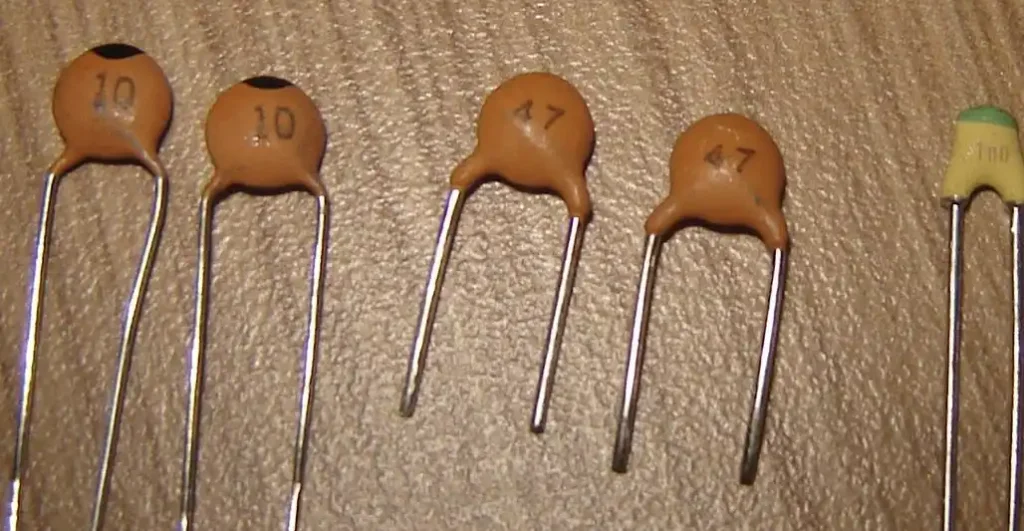Ceramic capacitors are vital components in electronic circuits, serving various functions like decoupling, filtering, and timing. Ensuring their reliability and functionality is crucial for maintaining the performance of electronic devices.
In this guide, we’ll delve into the methods and techniques for effectively testing ceramic capacitors.
What is a Ceramic Capacitor

Ceramic capacitors are widely used due to their small size, high capacitance values, and stability over a wide range of temperatures. They come in various types such as multilayer ceramic capacitors (MLCCs), which consist of alternating layers of ceramic material and metal electrodes.
Testing Methods:
- Visual Inspection: Begin by visually inspecting the ceramic capacitor for any physical damage, such as cracks, bulges, or discoloration. These signs may indicate internal faults or degradation.
- Capacitance Measurement: Using a digital multimeter (DMM) or a dedicated capacitance meter, measure the capacitance of the ceramic capacitor. Compare the measured value with the rated capacitance specified by the manufacturer. Significant deviations may indicate a faulty capacitor.
- Insulation Resistance Test: Measure the insulation resistance of the ceramic capacitor using a megohmmeter or a digital insulation resistance tester. This test helps identify any leakage current or insulation breakdown within the capacitor.
- Dielectric Absorption Test: Perform a dielectric absorption test by charging the capacitor to its rated voltage for a specific duration and then discharging it. Measure the voltage recovery curve to assess the capacitor’s dielectric absorption characteristics. An excessively slow recovery may indicate poor quality or internal defects.
- Equivalent Series Resistance (ESR) Measurement: Use an ESR meter to measure the equivalent series resistance of the ceramic capacitor. High ESR values can indicate aging, degradation, or internal faults within the capacitor.
- Temperature Testing: Subject the ceramic capacitor to temperature extremes within its specified operating range. Monitor its capacitance, insulation resistance, and other relevant parameters to evaluate its performance under varying temperature conditions.
Precautions:
- Ensure safety precautions when working with capacitors, especially when testing them at high voltages.
- Handle ceramic capacitors carefully to prevent physical damage during testing.
- Refer to the manufacturer’s datasheet for specific test procedures and precautions tailored to the capacitor type and application.
How to Test Ceramic Capacitor With Digital Multimeter

Testing a ceramic capacitor with a digital multimeter (DMM) is a straightforward process. Here are the steps to perform this test:
Select the Capacitance Measurement Function: Set your digital multimeter to the capacitance measurement function. This setting is usually denoted by a symbol resembling two parallel lines interrupted by a curved line, representing a capacitor.
Discharge the Capacitor: Before testing, ensure the capacitor is discharged to avoid any residual charge that could affect the measurement. If the capacitor was recently in use, short-circuit its terminals using a resistor to discharge it safely.
Connect the Leads: Connect the leads of the digital multimeter to the terminals of the ceramic capacitor. Ensure proper polarity; ceramic capacitors are non-polarized, so it doesn’t matter which lead goes where.
Read the Display: Once the leads are connected, the digital multimeter will display the measured capacitance value in farads (F), microfarads (µF), or picofarads (pF), depending on the capacitor’s capacitance rating. Note down the measured value.
Compare with the Rated Capacitance: Compare the measured capacitance value with the rated capacitance specified by the manufacturer. There may be a tolerance range within which the measured capacitance should fall. Ensure the measured capacitance is within this range.
Interpret the Results: If the measured capacitance closely matches the rated capacitance within the specified tolerance, the ceramic capacitor is likely functioning correctly. However, if the measured capacitance significantly deviates from the rated value or falls outside the specified tolerance range, it may indicate a faulty or degraded capacitor.
Repeat the Test (Optional): For added assurance, you can repeat the capacitance measurement multiple times, especially if the initial measurement shows unexpected results. Consistent readings across multiple tests strengthen the reliability of the assessment.
Record and Document: Record the measured capacitance value along with any relevant information such as the date of testing and the circuit or device in which the capacitor is used. This documentation can be useful for future reference and troubleshooting.
By following these steps, you can effectively test a ceramic capacitor using a digital multimeter, helping to ensure the integrity and functionality of electronic circuits and devices.
Related:
- 7+ Methods on How to Test a Capacitor With a Multimeter
- How to Test a Circuit Breaker
- How to Test Electronic Components? The Ultimate Guide
Conclusion
Testing ceramic capacitors is a crucial step in ensuring the reliability and performance of electronic circuits and devices. By following simple procedures using a digital multimeter, you can assess the integrity of ceramic capacitors quickly and effectively. From visual inspection to capacitance measurement, each step provides valuable insights into the capacitor’s condition.
Remember, regular testing and quality assurance practices contribute significantly to the longevity and stability of electronic systems. Whether you’re an electronics hobbyist, a technician, or a professional engineer, maintaining a rigorous testing regimen is essential for ensuring optimal performance.
Looking for high-quality ceramic capacitors at wholesale prices? Look no further! [Your Company Name] offers a wide range of ceramic capacitors suitable for various applications. Whether you need small quantities for personal projects or bulk orders for industrial applications, we’ve got you covered. Contact us today to get ceramic capacitors wholesale from us and experience superior quality and service firsthand. Let’s power up your projects together!